![]()
![]()
![]()
Use LEFT and RIGHT arrow keys to navigate between flashcards;
Use UP and DOWN arrow keys to flip the card;
H to show hint;
A reads text to speech;
39 Cards in this Set
- Front
- Back
|
What are the 3 elements we look at in urinalysis?
|
Appearance
Dipstick Sediment |
|
|
What are the components of appearance, dipstick, and characteristics?
|
*Appearance: Color, Turbidity, Odor.
*Dipstick: Specific gravity, pH, Protein, Glucose, Blood, Nitrite, Leukocyte esterase *Sediment: Cells, Casts, Bacteria, Yeasts, Parasites, Crystals, Artifacts, Mucus threads. |
|
|
Urine color--what does cloudy mean?
red/red-brown? yellow-brown? orange? green? |
*Cloudy: Cells (WBC, bacteria, epithelial cells), crystals
*Red or red brown: RBC, hemoglobin, myoglobin *Yellow-Brown Urine: Bilirubin (conjugated; NOT bound to albumin). *Other colors: Orange (rifampin); Green (amitriptyline, propofol) etc. |
|
|
What is the specific gravity of urine?
How does it compare to osmolality? |
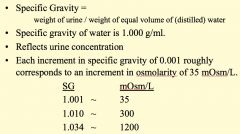
*Higher specific gravity = more concentrated urine.
|
|
|
What can specific gravity help you discern?
|
*Barometer of dipstick element concentrations
*Water disorders *Volume status of a patient |
|
|
What is the normal response to drinking too much water?
Abnormal? |
*Normal response to too much water (hyponatremia):
1) Remove water --> dilute the urine! -Urine will have low osm = low specific gravity. *Pathology: 1) Unable to excrete water (ADH is present) 2) Unable to excrete enough water (Too much water intake...like a marathon runner) |
|
|
What is the normal response to drinking too little water?
Abnormal? |
*Normal response to too little water (hypernatremia):
1) Retain water --> concentrate the urine! -Urine will have high urine osm = high specific gravity. *Pathology: 1) No stimulus to hold onto water (No ADH available=Diabetes insipidus). 2) Kidneys unable to hold onto water (ADH present but kidney can’t get rid of water). |
|
|
What are hyponatremia and hypernatremia?
How does urine specific gravity help identify the cause? |
Water disorders (Abnormal Na concentration)
1) Hyponatremia: *High specific gravity ~ Concentrated urine --> Diluting defect (inability to excrete water) *Low specific gravity ~ Dilute urine --> Diluting capacity exceeded. 2) Hypernatremia: *High specific gravity --> Lack of water intake. *Low specific gravity --> Concentrating defect (inability to hold onto water). |
|
|
What does specific gravity tell you in a state of hypovolemia?
|
*Hypovolemia:
1) Aldosterone 2) ADH *Presence of ADH is indicated by a high specific gravity. |
|
|
What is normal urine pH?
|
*Physiologic urine pH = 4.5 - 8.0
*Usual pH: 5-6 *pH should be determined promptly after urine collection because it can change with time. |
|
|
What kind of situations cause a high urine pH?
|
1) Urea-splitting bacteria.
2) Urinary stones: struvite stones. 3) Metabolic alkalosis --> exogenous alkali. 4) Metabolic acidosis: -Type I RTA (Renal Tubular Acidosis): Acidifying defect of the distal tubule. |
|
|
What situations cause a low pH?
|
*Normal finding due to organic acids from glucose metabolism.
*Paradoxical aciduria with metabolic alkalosis. |
|
|
What are normal urinary protein levels?
|
*Normal level < 150 mg protein/24 hr: usually 40-80 mg/day.
*Microalbuminuria: urinary albumin = 30-300 mg/day (normal albumin <30). *Strips are highly sensitive to albumin but NOT to other proteins (light chains, amino acids etc). |
|
|
Dipstick readings correspond to what protein levels?
What can cause false positive protein readings? 3 |
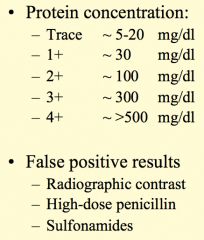
|
|
|
In what situations would you see glucose in the urine?
|
1) Nonfasting urine dipstick.
2) Diabetes (May also see ketones). 3) Other: Disorders of proximal tubular glucose reabsorption, e.g. Fanconi’s syndrome. *Consider Fanconi if there's a non-diabetic spilling glucose. |
|
|
How do we detect blood in the urine?
How do we actually see the CELLS? |
*Detection is based on the peroxidase activity:
-Hemoglobin -Myoglobin -you don't actually see the RBCs *Microscopic examination of the urine sediment is required to confirm presence of RBCs. *Contamination of urine is a possibility (menstruation, UTI). |
|
|
What does it mean if you have nitrites in your urine?
|

*Gram negative bacteria are present!
*False negative result: occurs when urine has not been retained in the bladder long enough (~ 4 hours) to permit sufficient production of nitrite. |
|
|
What does it mean if you have leukocyte esterase in your urine?
|
*Esterase is released by WBCs.
1) Urinary tract infection. 2) Interstitial nephritis (especially if no bacteria are present). 3) Tuberculosis. |
|
|
How do you obtain the urine sediment?
|
*Take 10 ml of clean-catched midstream urine.
*Centrifugation: 5 minutes @ 1500-2000 rpm in a urine collection tube. *Decantation of supernatant. *Pellet resuspension in remaining urine. |
|
|
What are 5 kinds of cells you may see in the urine?
|
Red blood cells (RBC)
White blood cells (WBC) Renal tubular epithelial cells (RTE) Squamous epithelial cells Bladder cells |
|
|
What are casts? What 5 kinds might you see in the urine?
|
*Formed in renal tubules, mostly in distal nephron.
RBC casts WBC casts Granular casts RTE casts Hyaline casts |
|

What are these and what situations may cause them to be in the urine?
|
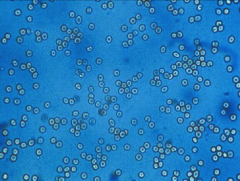
*RBCs!
*More than 2-3 per hpf (field) are pathologic. 1) Urinary tract infection 2) Urinary stones 3) Glomerulonephritis 4) Bladder pathology 5) Tumors |
|
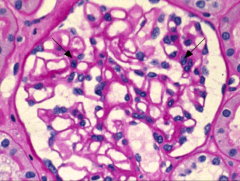
|
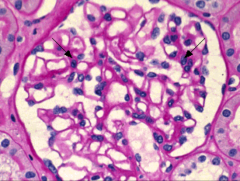
Glomerulus. Square indicates a capillary wall. Note that RBCs have to get from the capillary to the Bowman's space iot get into the urine.
|
|
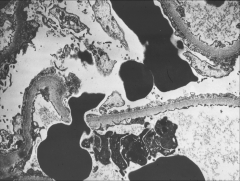
|
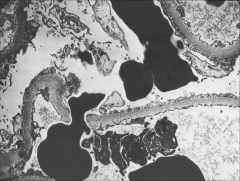
*Shows a RBC breaking thru the GBM and making it into the urinary space.
*This cell will be dysmorphic from the trauma of breaking thru. *Glomerulonephritis. |
|

|
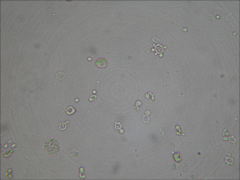
*Dysmorphic RBCs in glomerulonephritis.
|
|
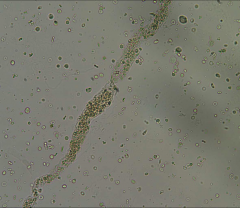
|
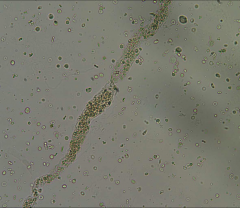
*RBC cast. Long, tubular shape. Some cellular elements are visible inside.
|
|

|
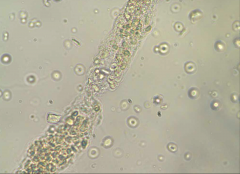
*High power RBC cast. Note the biconcave cells in the cast.
|
|
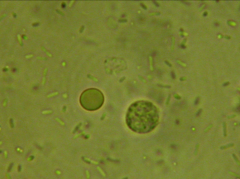
What is this? How many should you see in the urine normally? What situations will cause them to be elevated?
|
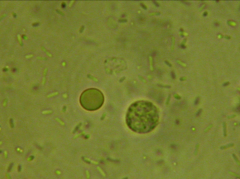
*WBC. Perfectly round with granularity. Can't be more specific than that.
*More than 4 WBCs per hpf are pathologic. 1) Infection (pyelonephritis) 2) Acute interstitial nephritis |
|

|
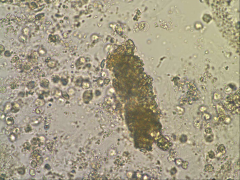
*WBC cast. Kind of hard to distinguish from a RBC cast, but note that all the surrounding cells are WBCs.
*Be suspicious of pyelonephritis or acute interstitial nephritis. |
|
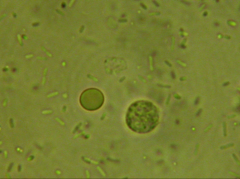
What are these and what causes them to be in the urine?
|

*Rods, most likely gram negatives.
1) Contamination 2) Colonization 3) Infection (you'll also see WBCs if this is the case). |
|
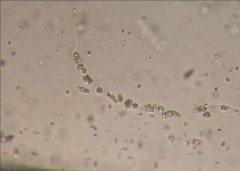
|
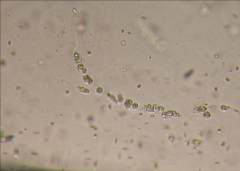
*Renal tubular epithelial cells.
*Some elongated, football shaped. Nucleus is off to the side. *Seen in acute tubular necrosis, early stage of injury. |
|
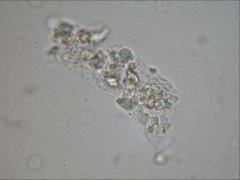
|
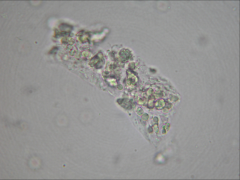
*Renal tubular epithelial cells.
*Seen in acute tubular necrosis, early stage of injury. *Epithelial cells that line the tubules *Ischemia/ toxic injury |
|
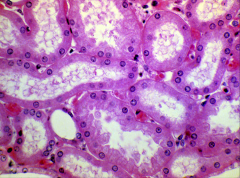
|
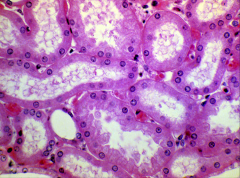
NORMAL renal tubules.
|
|

|
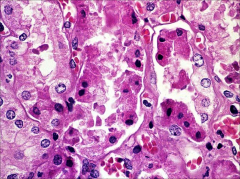
*Disruption of tubular lining in ATN. These cells will slough off into the urine.
|
|
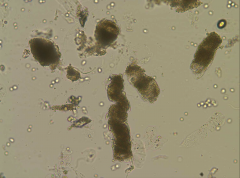
|
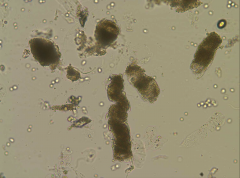
*Muddy brown casts in ATN. Membranes of these cells have been disrupted.
*Seen in acute tubular necrosis, LATE stage of injury; cells have been seriously degraded. |
|

|

*Light, slightly granular, hard to see. Hyaline cast!
*Not pathologic. *Tamm-Horsfall protein is secreted by the tubules. |
|
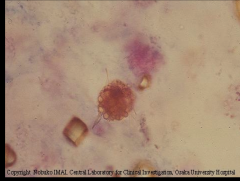
What is this?
When do you see this? |
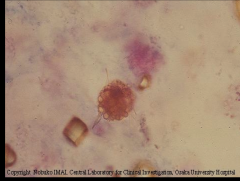
*Fatty casts seen in nephrotic syndrome!
|
|
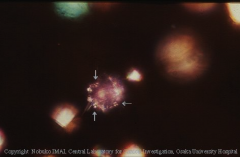
|
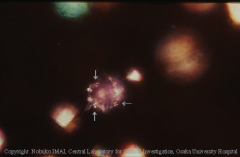
*Fatty casts under polarized light showing "Maltese cross sign."
*Seen in nephrotic syndrome! |
|
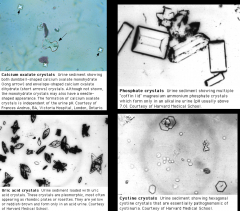
When do you see these in the urine?
|
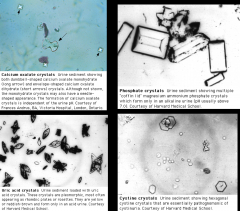
*Crystals!
1) Nephrolithiasis (most common). 2) Ethylene glycol toxicity. 3) Precipitation in old (cooled) urine. |

